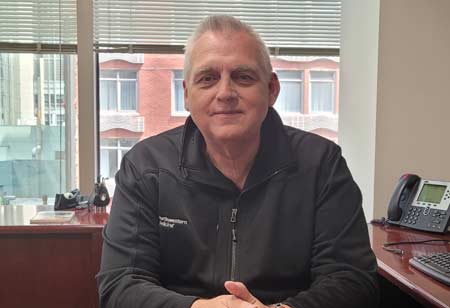Thank you for Subscribing to Healthcare Business Review Weekly Brief

Northwestern Memorial Healthcare Supply Chain Distribution & Logistics Daily Operating System
Healthcare Business Review
In 2018, Northwestern Medicine Supply Chain Distribution and Logistics began the journey of setting up our own operating system. The goal was to identify and implement best practices for all of our sites separated into four regions. Each region had to be aligned, standardized, and building together towards a culture of best practices and continuous improvement. We learnt a lot along the way, especially during the covid pandemic. It is safe to say that out of that adversity came inspiration and strength. We were bruised many times along the way but we did not break.
The adversity was justification of what we wanted to achieve. Through our journey we prevented confusion, stress, lack of communication and daily firefighting (especially through Covid) and set up a system that focused on being proactive and structured each day to respond immediately to our caregivers and our teams.
Northwestern Memorial Healthcare (NMHC) Background: Currently 12 hospitals and more than 200 outpatient locations are spread throughout the Illinois region. It is ranked 9th in size nationwide and 1st in Illinois. It has 30,000 employees, 4,400 physicians, 2,342 inpatient beds, 3.3 million outpatient encounters, 3,88,000 emergency department visits, 1,05,000 surgical cases, and 20,000 infant deliveries. A daunting challenge for the distribution and logistics team hence, having a project plan was the key to success.
Where were we prior to our transformation? All of our sites were being managed independently. The sites did not base any of their processes or daily work on standards or expectations. There was confusion about what our caregivers expected from us and consequently our teams were frustrated and disillusioned about their daily work. We had to find a better way but also one that was based on systematic thinking, stability in our operations and continuous improvement. The goal was about developing teams on each site to achieve the same high level and grow as one system.
Although we based our model on the Toyota Production System (TPS) it was important that we developed our own branding and methodology. A system that was applicable and focused on constantly challenging the status quo, and one that allowed our teams to become leaders engaged in positive change, and fulfilling work. The system is also focused on giving the best service to our caregivers and ultimately our patients.
The NM Supply Chain Operating System was developed and we addressed implementation in three distinct phases.
Phase 1
Foundational Stability: You must identify and implement stability in your day-to-day operations. Process standardization, daily huddles, high performing work environments, and problem solving were some of the key components. The goal was to achieve perfection, and the opportunity to measure our work, highlight our improvements, and create rhythm to our operations.
We needed to understand the voice of our caregivers (especially through covid) as well as the voice of our teams. How do we continue to provide value to our team’s daily work? A good team will deliver great results to our caregivers. Managers needed to become coaches and performance engineers needed to challenge inefficiency in our daily operations.
Collaboration platform governance: Our online collaboration site was not well managed and had differing standards, templates, and unneeded items.
We locked it down, cleaned it, reorganized it, and determined standard protocols to request, use, and update our improvements.
Become a learning organization: A standardized training slide deck about our operating system was developed, customizable to all levels from onboarding to senior leadership with a focus on what we change (tools and techniques) and why we change it (become a thinking system).
A structured and detailed communication program: Changing the way we work is challenging for both our leaders and our teams. Communication is one of the most important skills we needed to develop. At every stage of our transformation, we had to communicate effectively to both our teams and our customers. Daily readiness calls and multi-tiered daily huddles were established to ensure the teams were involved in all changes. Weekly leadership calls, system reviews and updates became part of our daily operations.
Phase 2
Concept of flow: Building on our foundational stability, we implemented best practices in our supply locations to manage our inventory more efficiently. Kanban (inventory management system), WaveMark (RFID inventory management technology), CaseCheck (bill-only supply management,) and RFID equipment tracking technologies were introduced. Data became our friend as we could now analyze our usage and offer opportunities for improvement to both our teams and caregivers. Capability in our processes and meaningful work greatly improved.
Anything is possible so long as we continue to develop and engage our teams to grow and consistently give the best service to our caregivers and our patients
Phase 3
Continuous improvement: Moving forward, we will implement a program for rapid improvement team events, lunch and learn programs, and leader training programs. Everyone is working towards developing a department of problem solvers.
What did we learn from the transformation?
The impact of changing the entire value stream and the way we work helped build stronger, more positive relationships within all areas of Supply Chain. Predictable and capable processes based on standardization and problem solving also made a huge difference. We also learned the power of our teams taking ownership of their daily work and building a culture of continuous improvement.
Where are we heading?
Initiatives such as process mining and AI technology are being introduced. The ability to analyze and develop improved value streams are all things we still need to understand. Fast paced change is happening but it still requires the same approach; foundational stability, challenging our practices, and continuous improvement in our operations. Anything is possible so long as we continue to develop and engage our teams to grow and consistently give the best service to our caregivers and our patients.









